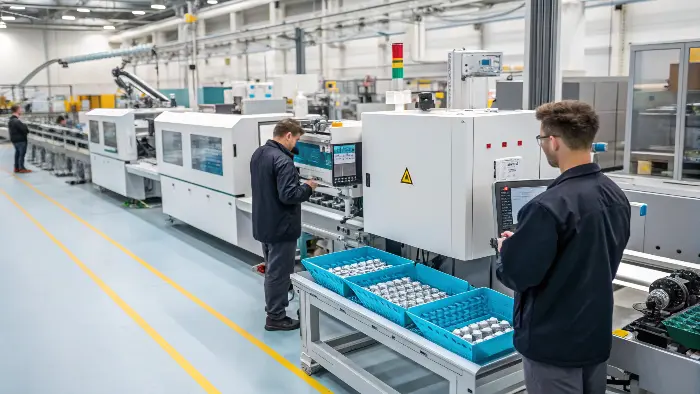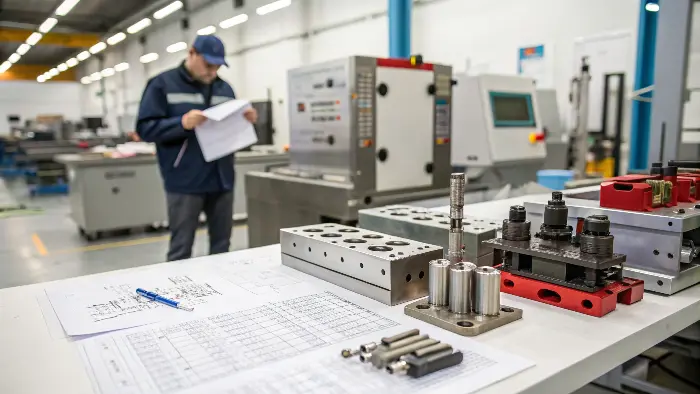Struggling with material waste and slow cycle times? Hot runners eliminate sprues, saving costs and boosting efficiency. Discover how.
Hot runner systems use heated components to keep plastic molten from the machine nozzle to the mold cavity, eliminating cold runners. This improves part quality, reduces material waste, shortens cycle times, and allows for more design freedom.
I’ve seen hot runner technology transform countless molding operations. It’s a significant step up from traditional cold runner systems, though it comes with its own set of considerations. Understanding the fundamentals is key to leveraging its full potential. Let’s dive into what makes these systems so effective and how you can choose the right one, helping you master molding right.
What is a Hot Runner System and How Does It Work?
Confused by how hot runners maintain molten plastic? Traditional cold runners create waste. Hot runners keep plastic flowing, directly into your part.
A hot runner system is an assembly of heated components within an injection mold. It uses manifolds and nozzles maintained at precise temperatures to deliver molten plastic directly into the mold cavities, eliminating the solidified runner system found in cold runner molds.
When I first encountered hot runner systems, the concept seemed almost magical compared to the cold runner molds I was used to. With cold runners, you always have that sprue and runner system – the solidified plastic pathways – that needs to be ejected with the parts and then either reground or discarded. This means material waste and an extra processing step.
A hot runner system, on the other hand, is like an extension of the injection molding machine’s nozzle. It consists of two main heated parts:
- The Manifold: This is a heated block of steel with channels machined into it. Molten plastic flows from the machine nozzle into the manifold, which distributes it towards the different cavities. Heaters and thermocouples embedded in the manifold maintain the plastic at its optimal processing temperature. I recall a project where a complex manifold design was crucial for evenly filling 16 cavities simultaneously; precise temperature control here was paramount.
- The Nozzles (or Drops): These are also heated components that connect the manifold to each individual mold cavity. They deliver the molten plastic directly to the gate of the part.
The entire system – manifold and nozzles – is kept hot, usually through electrical heating elements controlled by a sophisticated temperature controller. This ensures the plastic remains molten all the way to the part, so there’s no runner to solidify. Think of it as a network of heated tunnels guiding the plastic precisely where it needs to go. This precise control is a game-changer.What Are the Major Advantages of Implementing Hot Runner Technology?
Facing high material costs and slow production? Hot runners cut waste and speed up cycles. See the significant benefits they offer.
Key benefits include reduced material waste (no runners), faster cycle times (no runner cooling/ejection), improved part consistency, lower injection pressures, enhanced design flexibility (e.g., gate location), and potential for automation, ultimately lowering per-part costs.
The advantages of using hot runner systems are quite compelling, especially for medium to high-volume production. I’ve seen clients achieve remarkable improvements by switching. Here’s a breakdown of the main benefits:
- Material Savings: This is often the most significant benefit. Since there’s no cold runner to be ejected, there’s virtually no material waste associated with the feed system. For expensive engineering resins, this can lead to substantial cost savings. I remember a project using a pricey PEEK material; the hot runner paid for itself very quickly just from material savings alone, something Jacky, with his focus on cost reduction, would appreciate.
- Faster Cycle Times: Cold runners need time to solidify before the mold can open. Hot runners eliminate this, often leading to shorter cooling times and overall faster cycle times. This directly translates to increased productivity.
- Improved Part Quality and Consistency: Hot runners can provide more consistent melt temperature and pressure at each gate, leading to more uniform filling and better part-to-part consistency. They can also help reduce molded-in stress, a common challenge Jacky faces.
- Design Flexibility: Hot runner nozzles can often be placed more strategically than cold runner gates, offering greater freedom in part design and gate location. This can be critical for cosmetic parts or complex geometries. This also allows for gating directly onto the part surface without a visible runner mark.
- Lower Injection Pressures: Because the plastic remains molten, it flows more easily, often allowing for lower injection pressures. This can mean less wear on the mold and machine, and potentially the ability to run parts on smaller tonnage machines.
- Automation Friendliness: With no runners to separate, parts can often be directly demolded and packed, streamlining downstream automation, which is vital for large-scale production.
In Which Molding Applications Does Hot Runner Technology Truly Shine?
Unsure if hot runners suit your project? They excel with high volumes and tricky materials. Learn where they offer maximum impact.
Hot runners are ideal for high-volume production, parts made from expensive engineering resins, applications requiring fast cycle times, complex parts with multiple gates, and cosmetic parts where gate vestige needs to be minimized or hidden.

While hot runners offer many benefits, they aren’t universally the best choice for every single application. Their higher initial cost means they deliver the best return on investment in specific scenarios. From my experience, these are the areas where hot runners really shine, and where someone like Jacky would see immediate value:
- High-Volume Production: If you’re making millions, or even hundreds of thousands, of parts, the material savings and cycle time reductions from a hot runner system will quickly offset its higher upfront cost. This is key for mass-produced consumer electronics components.
- Expensive Engineering Resins: When molding materials like PEEK, LCP, PSU, or even some high-cost polycarbonates, the elimination of runner scrap is a massive financial advantage. I’ve seen material costs make or break a project, and hot runners can be the solution.
- Multi-Cavity Molds: For molds with many cavities, like those used for bottle caps or small connectors, hot runners ensure balanced filling and consistent parts across all cavities. This can be challenging with complex cold runner layouts.
- Cosmetic Parts: Where gate marks are undesirable, hot runner valve gates can provide a very clean gate vestige, often nearly invisible. This is crucial for consumer electronics housings, automotive interiors, and high-end packaging. Jacky’s work on aesthetic components would benefit greatly.
- Parts Requiring Complex Gating: For large parts needing multiple gates to fill properly, or parts with challenging geometries, hot runners offer superior control over melt delivery.
- Fast-Cycling Applications: In industries like packaging or medical disposables, where every fraction of a second in cycle time counts, hot runners are almost a standard.
Conversely, for very low-volume prototype runs or extremely simple parts made from cheap commodity plastics, a cold runner might still be more economical.How Do You Choose the Ideal Hot Runner System for Your Specific Mold?
Overwhelmed by hot runner options? Choosing the right system is key. Match nozzle type, manifold, and controls to your specific needs.
Selection involves considering the plastic material, part design (size, complexity, gate requirements), number of cavities, cosmetic requirements, and budget. Key choices include nozzle type (thermal gate, valve gate), manifold design, and temperature control system.

Selecting the right hot runner system isn’t a one-size-fits-all decision. It requires careful consideration of several factors. As a mold designer and someone who’s helped clients through this process many times, here are the key things I look at, similar to how Jacky would approach a design challenge:
- Plastic Material: The type of resin dictates the temperature range, flow characteristics, and even the materials used for the hot runner components themselves. For example, some plastics are corrosive or shear-sensitive, requiring special nozzle materials or designs.
- Part Design & Gate Requirements:
- Gate Type: Do you need a pinpoint gate, a valve gate for a clean vestige, or an edge gate? Valve gates offer the best gate control and surface finish but are more complex and expensive. Thermal gates (open gates) are simpler but leave a more noticeable gate mark. I often discuss with clients the trade-off between gate quality and system cost.
- Gate Location: Where can the gate be located on the part? This influences nozzle type and manifold layout. Poor gate location can lead to flow lines or warp.
- Part Size and Wall Thickness: This affects flow length and the number of gates needed.
- Number of Cavities: This determines the manifold design – whether it’s a simple ‘I’ or ‘H’ pattern or a more complex multi-level custom design that ensures balanced flow.
- Cosmetic Requirements: For Class A surfaces, valve gates are almost always preferred. I always push for this when the client’s product demands it.
- Supplier and Support: Choose a reputable hot runner supplier who offers good technical support, readily available spare parts, and experience with your specific application. This is crucial for minimizing downtime.
- Temperature Control: A precise and reliable temperature controller is essential for optimal performance. Zone control for each nozzle and manifold section is standard. I’ve seen poor temperature control ruin batches of parts.
My advice is always to work closely with both your mold maker and the hot runner system supplier. They can provide invaluable expertise to ensure you select a system that is optimized for your specific plastic, part, and production requirements. It’s an investment, so making an informed choice is critical.Conclusion
Hot runner technology significantly cuts waste and boosts molding efficiency. Proper system selection based on application needs is key to maximizing these benefits for your production.
